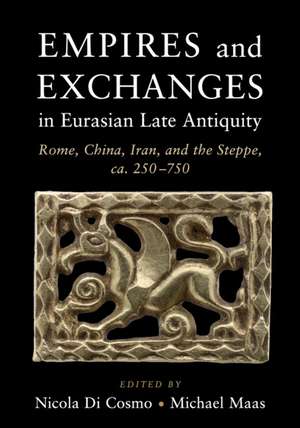Empires and Exchanges in Eurasian Late Antiquity: Rome, China, Iran, and the Steppe, ca. 250–750
Editat de Nicola Di Cosmo, Michael Maasen Limba Engleză Paperback – 19 aug 2020
Preț: 225.93 lei
Nou
Puncte Express: 339
Preț estimativ în valută:
43.24€ • 44.67$ • 35.98£
43.24€ • 44.67$ • 35.98£
Carte tipărită la comandă
Livrare economică 26 martie-09 aprilie
Preluare comenzi: 021 569.72.76
Specificații
ISBN-13: 9781107476127
ISBN-10: 1107476127
Pagini: 542
Ilustrații: 39 b/w illus. 9 maps
Dimensiuni: 180 x 256 x 30 mm
Greutate: 0.93 kg
Editura: Cambridge University Press
Colecția Cambridge University Press
Locul publicării:New York, United States
ISBN-10: 1107476127
Pagini: 542
Ilustrații: 39 b/w illus. 9 maps
Dimensiuni: 180 x 256 x 30 mm
Greutate: 0.93 kg
Editura: Cambridge University Press
Colecția Cambridge University Press
Locul publicării:New York, United States
Cuprins
Part I. Historical Thresholds: 1. How the steppes became Byzantine: Rome and the Eurasian Nomads in historical perspective Michael Maas; 2. The relations between China and the steppe from the Xiongnu to the Türk Empire Nicola Di Cosmo; 3. Sasanian Iran and the projection of power in Late Antique Eurasia: competing cosmologies and topographies of power Matthew P. Canepa; 4. Trade and exchanges along the silk and steppe routes in Late Antique Eurasia Richard Lim; 5. Sogdian merchants and Sogdian culture on the silk road Rong Xinjiang; 6. 'Charismatic' goods: commerce, diplomacy, and cultural contacts along the silk road in Late Antiquity Peter Brown; 7. The synthesis of the Tang Dynasty: the culmination of China's contacts and communication with Eurasia Valerie Hansen; 8. Central Asia in the Late Roman mental map, second to sixth centuries Giusto Traina; Part II. Movements, Contacts, and Exchanges: 9. Genetic history and migrations in Western Eurasia Patrick Geary; 10. Northern invaders: migration and conquest as scholarly topos in Eurasian history Michael Kulikowski; 11. Chinese and inner Asian perspectives on the history of the Northern dynasties (386–589 CE) in Chinese historiography Luo Xin; 12. Xiongnu and Huns: archaeological perspectives on a centuries-old debate about identity and migration Ursula Brosseder; 13. Ethnicity and empire in the Western Eurasian Steppes Walter Pohl; 14. The languages of Christianity on the silk roads and the transmission of Mediterranean culture into central Asia Scott Fitzgerald Johnson; 15. The spread of Buddhist culture to China between the third and seventh century Max Deeg; 16. The circulation of astrological lore and its political use between the Roman East, Sasanian Iran, Central Asia, and the Türks Frantz Grenet; 17. Luminous markers: pearls and royal authority in Late Antique Iran and Eurasia Joel Walker; Part III. Empires, Diplomacy, and Frontiers: 18. Byzantium's Eurasian policy in the age of the Türk Empire Mark Whittow; 19. Sasanian Iran and its northeastern frontier: offense, defense, and diplomatic Daniel T. Potts; 20. Infrastructures of legitimacy in inner Asia: the Early Türk Empires Michael R. Drompp; 21. The stateless Nomads of Central Eurasia Peter B. Golden; 22. Aspects of elite representation among the sixth- to seventh-century Türks Sören Stark; 23. Patterns of Roman diplomacy with Iran and the steppe peoples Ekaterina Nechaeva; 24. Collapse of a Eurasian hybrid: the case of the northern Wei Andrew Eisenberg; 25. Ideological interweaving in Eastern Eurasia: simultaneous kingship and dynastic competition Jonathan Karam Skaff; 26. Followers and leaders in northeastern Eurasia, ca. seventh to tenth centuries Naomi Standen; Epilogue Averil Cameron.
Recenzii
'It is difficult in a brief review to do justice to such a rich variety of contributions, but enough has been said to give a flavor of the riches before us. This is an inspiring book. It establishes Eurasian Late Antiquity as a cohesive area of study at the same time as it demonstrates the sheer excitement of the subject. The editors have done us a great service in bringing together such a thought provoking volume.' Barry Cunliffe, Asian Perspectives
'… Di Cosmo and Maas' volume makes a convincing case for historians and archaeologists to take a Eurasian perspective when studying their particular regions or sites.' Arezou Azad, Medieval Archaeology
'… Di Cosmo and Maas' volume makes a convincing case for historians and archaeologists to take a Eurasian perspective when studying their particular regions or sites.' Arezou Azad, Medieval Archaeology
Descriere
This book offers an integrated picture of Rome, China, Iran, and the Eurasian Steppes during a formative period of World History.
